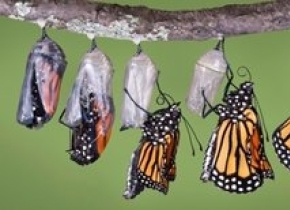

随着气温的上升,种植在美国南部非本地马利筋可能会对黑脉金斑蝶造成伤害。
播音\撰文:贾森·G·戈德曼(Jason G. Goldman)
翻译:曲荟龙
校对:张艺箫
Monarch butterflies depend on milkweed. They lay their eggs on milkweed, and their caterpillars eat only the leaves of the plant. No milkweed means no monarchs. So the best way to help declining monarch populations—and to preserve their epic, multi-generational migration—is to plant milkweed.
黑脉金斑蝶的生存离不开马利筋。它们在马利筋上产卵,卵孵化出的幼虫也只能以马利筋的叶子为食。没有马利筋就没有黑脉金斑蝶。所以,控制黑脉金斑蝶数量减少并帮助它们繁衍后代的最好方式,就是种植马利筋。
Seems simple, right? But the reality is far more complicated.
这种方法看起来很简单对吧?但现实却要比这复杂得多。
Milkweed is slightly toxic—the plant evolved its noxious substances to keep herbivores from chowing down on the leaves. But monarch butterflies evolved tolerance. In fact, they arm themselves with the stuff.
马利筋具有轻微的毒性——经过进化,这种植物可以分泌出有毒物质,来阻止食草动物啃食自己的叶子。不过进化也使黑脉金斑蝶获得了耐毒性。事实上,它们用这种‘耐毒性’来武装自己。
"Monarchs sequester these toxins as an anti-predator defense and anti-parasite defense.”Louisiana State University biologist Matt Faldyn.
“黑脉金斑蝶将这些毒素应用于自己的防御系统,以阻止掠食者和寄生虫的进攻。” 路易斯安那州立大学的生物学家马特·法尔丁说。
So, by ingesting the toxin, the caterpillars become toxic themselves. That keeps them safe—as long as they don't ingest too much of the poison. The problem is there are different types of milkweed. And one that’s native to the tropics is now growing in the southern U.S. As these plants sense warming temperatures, they produce more of the toxin—so much more that the monarch butterflies begin to suffer.
就这样,通过不断摄入来源于马利筋的毒素,黑脉金斑蝶的幼虫也会具有了毒性。这种毒性使黑脉金斑蝶保证自身的安全——前提是不过量摄入毒素。但问题是马利筋有很多种类。一种原产于热带地区的马利筋现在广泛生长在美国南部。这些植物会随着温度的上升,而产生更多的毒素,黑脉金斑蝶会因此受到伤害。
To gauge the threat, Faldyn and his team raised monarchs on either the non-native tropical milkweed or on a native milkweed. And they also tested the effects of current environmental conditions as well as temperatures expected for the southern U.S. by the year 2080.
为了评估这一威胁性,法尔丁和其团队分别在非本地的热带马利筋和本地的马利筋上饲养黑脉金斑蝶。并检测了目前环境的状况及2080年美国南部的预期气温。
Monarchs that ate native milkweed had comparable survival rates at both current and higher temperatures. But under those future warmer conditions, monarchs raised on the tropical milkweed survived at only one fifth the rate of butterflies raised under current conditions.
结果显示,食用本地马利筋的黑脉金斑蝶无论是在当前温度还是在更高的温度下生存率都相当高。与之相对,依靠热带马利筋生存的黑脉金斑蝶在未来更温暖的条件下,生存率仅有当前条件下的五分之一。
The monarchs could thus find themselves in what's known as an ecological trap. The butterflies seek out milkweed, but what is already the most common type of milkweed in the southern U.S. will eventually kill them.
黑脉金斑蝶陷入了“生态陷阱”。为了生存,它们寻找马利筋,但这种已经是美国南部最常见的一种马利筋却会在最终害死它们。
The tropical species is prettier than the native ones, which is why many people prefer to plant it. But there’s still time to change that.
这种热带马利筋比本地马利筋更漂亮,因此许多人更喜欢种植它们。不过现在还有时间来改变这种状况。
"What we show is that maybe there should be more of a focus on having native species to your area preferentially planted in your gardens.”
“实验结果给了我们一种启示——也许人们在为自己的花园添置植物时应该优先选择本地物种。”
By switching to the native species, home gardeners across the country can each do their part to ensure that monarch butterflies will avoid fluttering their way into the ecological trap—which could be fatal.
只要全美人民都尽自己的一份努力,选择种植本地马利筋而非热带马利筋,就能避免黑脉金斑蝶进入生态陷阱——这种陷阱对于它们来说可能是致命的。
 京公网安备11010502039775号
京公网安备11010502039775号